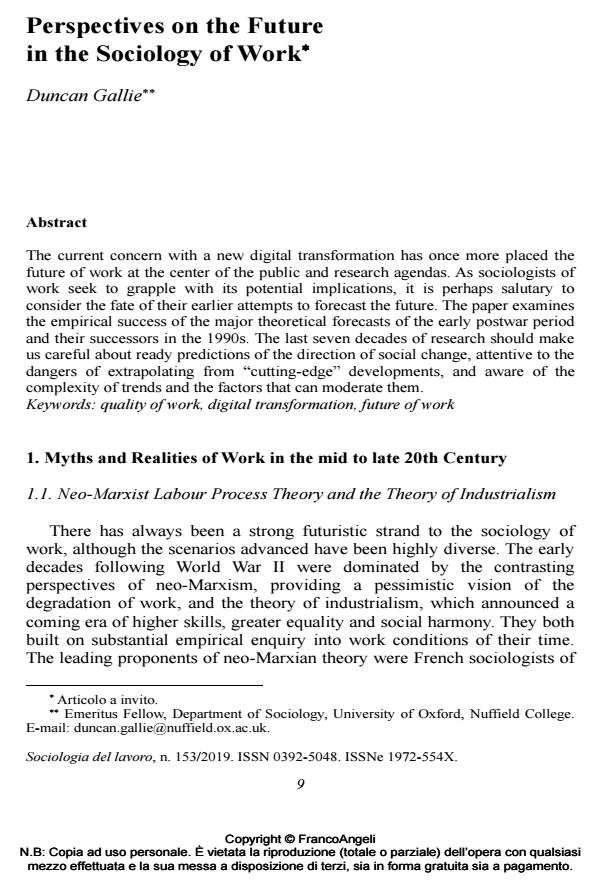Perspectives on the Future in the Sociology of Work
Titolo Rivista SOCIOLOGIA DEL LAVORO
Autori/Curatori Duncan Gallie
Anno di pubblicazione 2019 Fascicolo 2019/153
Lingua Inglese Numero pagine 23 P. 9-31 Dimensione file 298 KB
DOI 10.3280/SL2019-153002
Il DOI è il codice a barre della proprietà intellettuale: per saperne di più
clicca qui
Qui sotto puoi vedere in anteprima la prima pagina di questo articolo.
Se questo articolo ti interessa, lo puoi acquistare (e scaricare in formato pdf) seguendo le facili indicazioni per acquistare il download credit. Acquista Download Credits per scaricare questo Articolo in formato PDF

FrancoAngeli è membro della Publishers International Linking Association, Inc (PILA)associazione indipendente e non profit per facilitare (attraverso i servizi tecnologici implementati da CrossRef.org) l’accesso degli studiosi ai contenuti digitali nelle pubblicazioni professionali e scientifiche
The current concern with a new digital transformation has once more placed the future of work at the center of the public and research agendas. As sociologists of work seek to grapple with its potential implications, it is perhaps salutary to consider the fate of their earlier attempts to forecast the future. The paper examines the empirical success of the major theoretical forecasts of the early postwar period and their successors in the 1990s. The last seven decades of research should make us careful about ready predictions of the direction of social change, attentive to the dangers of extrapolating from "cutting-edge" developments, and aware of the complexity of trends and the factors that can moderate them.
Le attuali preoccupazioni per le conseguenze della nuova trasformazione digitale hanno, ancora una volta, portato il lavoro e le sue evoluzioni future al centro del dibattito pubblico e dei programmi di ricerca. I sociologi del lavoro sono impegnati a comprendere le potenziali implicazioni della digitalizzazione e a supporto di que-sto sforzo è forse utile andare a considerare l’esito dei tentativi di prevedere il futu-ro del lavoro in altre epoche. Il saggio esamina il grado di successo empirico delle principali previsioni teoriche del primo periodo postbellico e dei successori negli anni '90. Le ricerche di questi decenni dovrebbero metterci in guardia rispetto a sbrigative previsioni sulla direzione del cambiamento sociale, sui pericoli del deri-vare gli sviluppi futuri dalle "avanguardie" e dare maggiore consapevolezza della complessità delle tendenze e dei fattori che possono moderarle.
Parole chiave:Qualità del lavoro, trasformazioni digitali, futuro del lavoro
- Non di solo pane? Qualità del lavoro e soddisfazione per il proprio impiego: un approccio multidimensionale Tania Parisi, in SOCIOLOGIA DEL LAVORO 161/2021 pp.148
DOI: 10.3280/SL2021-161008 - Rileggere gli occupati e i disoccupati. Note a partire dai volumi I paradossi della disoccupazione, di A. Accornero e F. Carmignani, Sociologia della disoccupazione, di E. Pugliese, Se tre milioni vi sembrano pochi, di L. Gallino Andrea Ciarini, in SOCIOLOGIA DEL LAVORO 154/2019 pp.225
DOI: 10.3280/SL2019-154012
Duncan Gallie, Perspectives on the Future in the Sociology of Work in "SOCIOLOGIA DEL LAVORO " 153/2019, pp 9-31, DOI: 10.3280/SL2019-153002